Tourist primus stove: description, types and choice

Tourist stoves are modern gasoline and gas appliances that allow you to cook food in field conditions. They are absolutely irreplaceable in travels and on vacation "savages". Most of these appliances provide fairly quick heating of dishes, make it easy to cook food in a pot or pan, and do not require complex maintenance. Buying the right fuel is also not difficult. We will consider in the article how to choose the optimal model of a tourist stove so as not to find yourself in difficult conditions without access to hot meals.


What is it and why is it needed?
A tourist primus stove is a portable device that provides opportunities for using a fire source outside of access to stationary stoves. From the very beginning, this category of burners included exclusively liquid fuel models - kerosene, gasoline. Among modern options, you can also find gas solutions that have a fairly good efficiency, and are also more convenient to transport.
All primuses are different wickless type of construction and, in fact, resemble a blowtorch. When supplied under pressure, the fuel provides the necessary intensity of combustion.The burner, which is part of the design, provides opportunities for distributing heat when heated along the bottom of the dish.

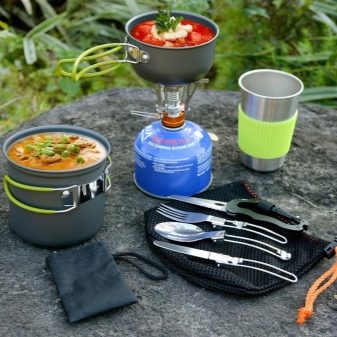
At one gas station the product can work up to 50-60 minutes. In some cases, models are used in which a gas cylinder acts as a fuel.
The first stoves were not camping equipment, they were used in stationary conditions. In the future, they were highly appreciated by travelers, tourists, hikers, expedition members. In Russia, households were equipped with stoves, which have not yet reached universal gasification. Own production has been established in the country since 1922, today the scope of use of the device is limited mainly to areas not related to the household.


Advantages and disadvantages
Primus stoves, which have a rich history of use in many countries of the world, have their pros and cons. Some of the benefits of these heaters include:
- the highest efficiency - much higher than that of other types of autonomous heating devices;
- compact dimensions, convenient for transportation and carrying;
- low fuel requirements;
- adaptability to work in almost any conditions;
- the ability to quickly resolve problems with fuel - you can buy gasoline or a gas cylinder in any country in the world.


There are also many disadvantages. Without experience, it is quite difficult to deal with the ignition process. Gasoline models are prone to clogged injectors due to the nature of the fuel. Kerosene-powered options are more reliable. Also, the burner tubes can accumulate plaque inside, resulting from the combustion of fuel.
In some models, when burning, there is a strong noise.In addition, stoves in general are difficult to classify as environmentally friendly and safe types of heating devices.
Equipment may explode if misused.

Varieties
Among the existing varieties of primus stoves, several design options can be noted.
- Kerosene. Considered obsolete, such models can be attributed to the ancestors of camping equipment for cooking. Due to the difficulty of obtaining access to high-quality fuel, kerosene stoves today are practically unclaimed. It is quite difficult to find them on sale, but with proper care and maintenance, it is quite possible to use models released several decades ago.

- Petrol. The universal device providing an opportunity for operation in the most difficult conditions. The equipment operates at temperatures down to -50 degrees Celsius. The devices are suitable for outdoor use only. They cannot be placed inside the tent, certain precautions must be observed.
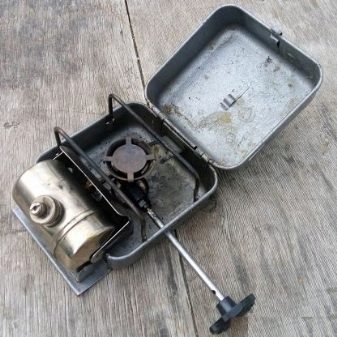

- Gas. Modern models with 5 l cylinders or compact replaceable cartridges are characterized by a high level of safety. Fuel consumption is much lower here, and finding a gas station is also easy. During the combustion of gas, no dangerous compounds are formed, soot accumulating on the walls of the fuel supply tube. Modern tourists are increasingly choosing this option for use in field conditions.
Comparing kerosene, gasoline and gas appliances, you can easily make the final choice, securing the purchase of a modern primus stove for tourism and hiking.

Popular Models
Modern manufacturers produce a number of models of camping stoves.Among them, you can find both classic liquid fuel and gas options with different battery life.

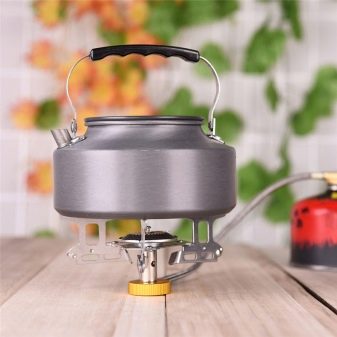
Primus MFS 3288
Multi-fuel burners, characterized by versatility of use. The model can run on kerosene and gasoline, supports the connection of gas cylinders. The design of the burner provides for the presence of folding legs, the connection to the fuel tank is carried out using a flexible hose in a metal braid. Estimated power 2800 watts. The popularity of the model has been repeatedly confirmed by tourists and hikers with different levels of experience.

"PT-1"
The classic model of a primus stove, which includes the burner itself, a funnel for pouring fuel, a universal key, spare parts (oil seals) and a handle. Motor gasoline with a low octane number acts as a fuel. The fuel tank holds 120 ml, which is enough for 35 minutes of operation at maximum power. A liter of water boils in 8 minutes, at one gas station you can boil a kettle, cook soup.
The absence of a pump makes the operation of this liquid fuel stove easier and more understandable. The product requires preliminary heating of the bowl with dry or liquid fuel. The pressure formed inside allows the fuel to be displaced, when it hits the burner, it becomes vaporous, quickly burns out. The model costs less than 2000 rubles, has a long service life.

Motor Sich PT-2 and Motor Sich PT-3
Primuses of Ukrainian production, the pressure in the system of which is pumped with a pump. The difference between the modifications lies in the fuel consumption - 0.25 or 0.3 liters per hour, the estimated power is 3 kW. Primuses among experienced tourists are considered unfinished, almost always the purchased product has to be finalized with a file, to change components. When warming up on the burner, it is recommended to use dry fuel.
Products are characterized by quiet operation, high speed of water heating. Comes with a handy carrying and storage case.


"Bumblebee"
Primuses "Bumblebee" were produced in 4 modifications, which differed in the volume of the fuel tank. Today this type of product is produced in Kazakhstan and is called "Dastan". Standard fuel consumption per day is about 35 ml per person. Heptane or pure gasoline for cars is used as a fuel. The model has a pump used to pressurize.
Among the distinctive characteristics of the modern version of the "Bumblebee" can be noted a significant tank capacity - 0.8 liters, which is enough for continuous burning for 3.5-5 hours. Primus supports the use of dishes with a bottom diameter of up to 210 mm. Having studied the review of the traveling models "PT-1", "Motor Sich PT-2" and "PT-3", "Bumblebee", you can determine their technical characteristics and make a final decision.


How to choose?
When purchasing the necessary camping equipment, it is necessary to pay attention to the correct selection of a primus stove. Making a choice in favor of gas or liquid fuel models can be quite difficult. But the first thing to consider: the seasonality of the use of equipment. Gas versions have a limitation on the temperature regime of use - upon reaching the threshold of -30 degrees Celsius, it does not burn well. For extreme tourism, liquid-fuel primus will be the most preferable option.
User experience is also important. Gas versions do not require complex refueling - in most cases, disposable replaceable cylinders or regular 5-liter containers are used. Compact models are even suitable for use inside a spacious tent. Not every experienced hiker can handle liquid fuel options. If a stove is bought for mountain climbing or a long expedition, liquid fuel options will be the best solution.
For especially difficult conditions, you can purchase a combined multi-fuel option. In this case, the burner will have interchangeable nozzles for switching between different fuel versions.

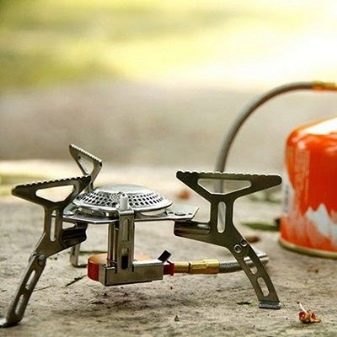
And also for comfortable operation, a number of other important characteristics should be taken into account.
- Boiling rate of 1 liter of water. The measurement must be made at room temperature. The manufacturer usually indicates this parameter, or it can be found in the user reviews of stoves.
- Maximum fuel consumption. Considering that fuel has to be carried or carried with you, this factor will be important.
- Mass and dimensions of the burner. When traveling with a backpack, it is better to choose the most compact solutions.
- Availability of various options. The most useful in hiking conditions are piezo ignition and the ability to adjust the flame.
Considering all these points, it is possible to ensure the correct selection of a primus stove for a hike, trip or use in the country.
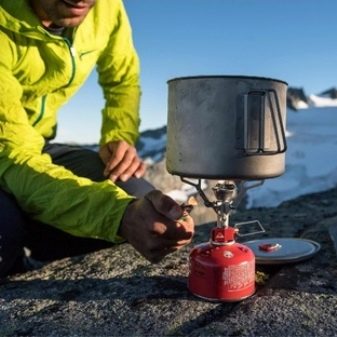

Subtleties of operation
When using stoves, it is very important to follow certain rules. Among the general recommendations, one can distinguish a ban on operation in poorly ventilated rooms. When operating in a tent or trailer environment, it can be quite difficult to provide sufficient security measures.Primuses are appliances with an increased level of fire danger, their burner must always remain open. If overheated, the heater may simply explode.
During the operation of a stove based on liquid fuel, the ignition procedure will be as follows:
- pouring fuel into a special tank within 2/3 of its full volume;
- in the presence of a pump - pumping air pressure in the tank;
- warming up the burner by pouring fuel into its bowl with its almost complete combustion;
- opening the fuel supply, when ignited, it should give a blue flame.

If there is no cup in the stove, you can do without preheating. Initially, when ignited, the flame here has a yellow tint, after warming up it becomes blue. You can extinguish the primus with the help of a special adjusting screw. They cut off the fuel supply, then you need to wait until the primus cools down. In the future, you need to use the air screw, and relieve pressure.
Primus on liquid fuel must have a special safety valve to prevent overheating. But do not forget that when the pressure is released, a splash of fuel occurs, and it can cause a fire.

Refueling and topping up takes place only in a cooled primus stove. Do not perform these manipulations with a hot device.
In the next video you are waiting for the launch, test and impressions of the PT-3 tourist stove.




























